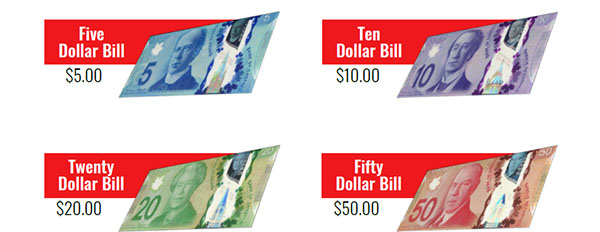
 Let’s Write, Partner!
Let’s Write, Partner!
Be part of the Creative Writing Roundup with The Canadian Schoolhouse! This year’s publication is called Journey Back in Time: Rounding Up Stories about the Past. History is all around us and presented in so many ways. It’s time for you to tell us a bit of history. All throughout April we’ll be giving out writing tips, course samples (from SchoolhouseTeachers.com), and many other resources through email and video to equip you to inspire your children to write their very own historical fiction or factual story.
Writing submissions accepted from April 1 until April 30.

Money is used every day across Canada in transactions such as purchases, sales, loans, and borrowing/lending. Learning about the history of Canadian money and fun facts can help you understand more about the important role money has in daily life.
The Royal Canadian Mint
The Royal Canadian Mint, with locations in Ottawa and Winnipeg, is the producer of Canada’s circulation coin. The Royal Canadian Mint is a Crown Corporation of the government of Canada. The Mint offers tours at both its Winnipeg and Ottawa locations as well as virtual tours. Virtual tours are 35 to 45 minutes long. The tours can be a great field trip and a way of learning more about the Mint and the Canadian currency.
Coins

First known as the Royal Mint when it began in 1908, the first coin was “a gold sovereign with a “C” for Canada.” Each Canadian coin has an image on it different from the other coins:
- Two-dollar coins, or toonies, have an adult polar bear. The polar bear design was created by wildlife and landscape artist Brent Townsend. On February 19, 1996, the toonie was introduced to replace the two dollar bill. The toonie has a distinct bi-metallic look made from pure nickel surrounding a copper alloy centre and locking mechanism.
- One-dollar coins, or loonies, show a loon floating on water. Wildlife artist Robert-Ralph Carmichael designed the loon image. The loonie came into circulation in 1987, with the nickname of loonie emerging soon after, as a cost-saving measure to replace dollar bills. The loonie is made from bronze-plated nickel.
- Quarters, or 25-cent coins, have a caribou. The caribou image was designed by artist Emmanuel Hahn and was first used on the quarter in 1937.
- Dimes, or 10-cent coins, show the Nova Scotia schooner, the Bluenose. The Bluenose design was first introduced in 1937 and was designed by Emmanuel Hahn.
- Nickels, or 5-cent coins, have a beaver. G. E. Kruger Gray designed the image, and the beaver first appeared on nickels in 1937.
Originally made mainly from silver, the quarter, dime, and nickel are now all made mainly from steel, comprising over 90% of the material the coins are made of.
The above images on the coins are on the “tails” side of the coin. The reverse side, or “heads” side, of all Canadian coins showcase the profile of Queen Elizabeth II, the current reigning constitutional monarch of Canada.
Up until 2012, the Royal Canadian Mint produced the penny or one-cent coin. The image found on the penny was two maple leaves on a single twig. This design of the two maple leaves on the twig was first created in 1937 by G. E. Kruger Gray. Similar to the other Canadian coins, the penny was also made of over 90% steel with a copper plating. On March 29, 2012, the Canadian government announced that the one-cent coin, or penny, would be discontinued as the cost to produce the coin was more than the face value.
For events or occasions, the Royal Canadian Mint issues special circulating coins “… such as the coloured Poppy quarter, the Millennium series of 25-cent coins, and the 2010 Vancouver Olympic mascot coins.”
Canadian and American coins are similar in size, name of the coin (quarter, dime, nickel, and penny), and how they look from a distance. In Canada, American coins are accepted at par. This is the reason why you will sometimes find American coins mixed in with Canadian change.
Bills

Canada’s paper money, or bills, come in amounts of $5, $10, $20, $50, and $100. Each paper money has its own colour which makes it easier to distinguish which bill is what amount. The colours of the paper money are as follows:
- $5 bill: blue
- $10 bill: purple
- $20: green
- $50: red
- $100: brown
Briefly, in 1935, Canada had $25 and $500 bills. Until the year 2000, $1,000 bills were in circulation. As of January 1, 2021, the legal tender status of $1, $2, $25, and $1,000 bills was removed.
Accompanying this article are worksheets on Canadian Money. The first page shares pictures of Canadian coins and paper money. Pages two and three are for practice with counting money up to amounts of $1. Pages four and five are for practice with counting money up to amounts of $10. The last two pages, six and seven, provide practice for counting money up to amounts of $100.
The worksheets can be used as a supplement to your family’s math studies, or it can be an opportunity to perhaps create a unit study around money in Canada including its history, production, and uses.
You may also like:
This article has been written by homeschooling staff writers of The Canadian Schoolhouse (TCS). Enjoy more of our content from TCS contributors and staff writers by visiting our Front Door page that has content on our monthly theme and links to all our content sections.













